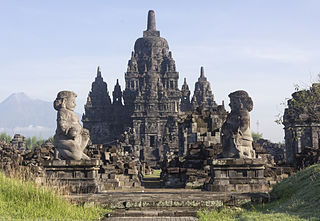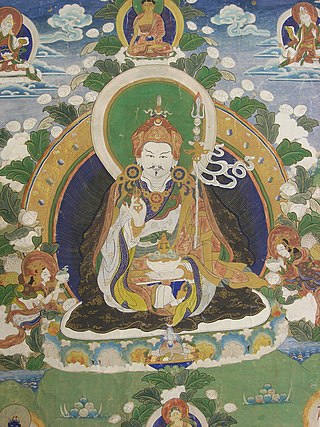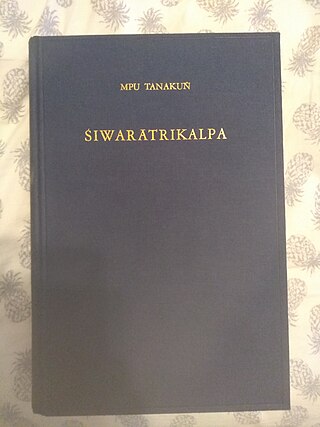Related Research Articles
Old Javanese or Kawi is the oldest attested phase of the Javanese language. It was spoken in the eastern part of what is now Central Java and the whole of East Java, Indonesia. As a literary language, Kawi was used across Java and on the islands of Madura, Bali, and Lombok. It had a sizable vocabulary of Sanskrit loanwords but had not yet developed the formal krama language register, to be used with one's social superiors that is characteristic of modern Javanese.

Bhinneka Tunggal Ika is the official national motto of Indonesia, inscribed in the National emblem of Indonesia, the Garuda Pancasila, written on the scroll gripped by the Garuda's claws. The phrase comes from the Old Javanese, translated to as "Unity in Diversity." The phrase is also mentioned in the Constitution of Indonesia, specifically in article 36A. The motto refers to the unity and integrity of Indonesia, a nation consisting of various cultures, regional languages, races, ethnicities, religions, and beliefs.
In the Buddhist tradition, the five hindrances are identified as mental factors that hinder progress in meditation and in daily life. In the Theravada tradition, these factors are identified specifically as obstacles to the jhānas within meditation practice. Within the Mahayana tradition, the five hindrances are identified as obstacles to samatha (tranquility) meditation. Contemporary Insight Meditation teachers identify the five hindrances as obstacles to mindfulness meditation.

Eihei-ji (永平寺) is one of two main temples of the Sōtō school of Zen Buddhism, the largest single religious denomination in Japan. Eihei-ji is located about 15 km (9 mi) east of Fukui in Fukui Prefecture, Japan. In English, its name means "temple of eternal peace".

A Buddhist temple or Buddhist monastery is the place of worship for Buddhists, the followers of Buddhism. They include the structures called vihara, chaitya, stupa, wat and pagoda in different regions and languages. Temples in Buddhism represent the pure land or pure environment of a Buddha. Traditional Buddhist temples are designed to inspire inner and outer peace.
Kyozan Joshu Sasaki, Roshi was a Japanese Rinzai Zen teacher who lived in Los Angeles, United States since 1962. He was one of the most influential but also controversial Zen masters in America, "coercing hundreds of [students] into having sexual contact with him" since at least the early 1970s. He sought to tailor his teachings to westerners, opening dozens of centres, and founding serving as head abbot of the Mount Baldy Zen Center, near Mount Baldy in California, and of the Rinzai-Ji order of affiliated Zen centers.

The Jogye Order, officially the Jogye Order of Korean Buddhism, is the representative order of traditional Korean Buddhism with roots that date back 1200 years to the Later Silla National Master Doui, who brought Seon and the practice taught by the Sixth Patriarch, Huineng, from China around 820 CE. The name of the Order, Jogye, was adopted from the name of the village where Patriarch Huineng's home temple, Nanhua Temple, is located,.

A vajrācārya is a Vajrayana Buddhist master, guru or priest. It is a general term for a tantric master in Vajrayana Buddhist traditions, including Tibetan Buddhism, Shingon, Bhutanese Buddhism, Newar Buddhism.

Buddhism has a long history in Indonesia, and is one of the six recognized religions in Indonesia, along with Islam, Christianity, Hinduism and Confucianism. According to 2022 estimates roughly 0.7% of the total citizens of Indonesia were Buddhists, and numbered around 2 million. Most Buddhists are concentrated in Jakarta, Riau, Riau Islands, Bangka Belitung, North Sumatra, and West Kalimantan. These totals, however, are probably inflated, as practitioners of Taoism and Chinese folk religion, which are not considered official religions of Indonesia, likely declared themselves as Buddhists on the most recent census. Today, the majority of Buddhists in Indonesia are Chinese, however small communities of native Buddhists also exist.

Kakawin Hariwangsa is an Old Javanese poem in Indian metres which tells the story of Krishna, as an Avatar of Vishnu, when he wished to marry the Goddess Rukminī, from the land of Kundina, and daughter of Lord Bhishmaka. Rukmini is an avatar of the goddess Śrī.
Kakawin are long narrative poems composed in Old Javanese, also called "Kawi", written in verse form with rhythms and meters derived from Sanskrit literature. Poets used a formalized literary language, rather than the vernacular. Poets composed and performed the poems at the courts of central and east Java kings between the 9th and 16th centuries, and in Bali.

Yaśodharā was the wife of Prince Siddhartha — until he left his home to become a śramaṇa— the mother of Rāhula, and the sister of Devadatta. She later became a Bhikkhunī and is considered an arahatā.
Kalyāṇa-mittatā is a Buddhist concept of "admirable friendship" within Buddhist community life, applicable to both monastic and householder relationships. One involved in such a relationship is known as a "good friend", "virtuous friend", "noble friend" or "admirable friend".

The Three Ages of Buddhism, also known as the Three Ages of the Dharma, are three divisions of time following Shakyamuni Buddha's death and passing into Nirvana in East Asian Buddhism.
Sugata is a Sanskrit epithet for Gautama Buddha.

The Twin Miracle, also called the Miracle at Savatthi (Pali), or the Miracle at Śrāvastī (Sanskrit), is one of the miracles of Gautama Buddha. There are two major versions of the story that vary in some details. The Pali account of the miracle can be found in the Dhammapadattakatha and the Sanskrit version in the Pratiharya-sutra. Buddhists believe it was performed seven years after the Buddha's enlightenment, in the ancient Indian city of Savatthi. According to Buddhist texts, during the miracle the Buddha emitted fire from the top half of his body and water from the bottom half of his body simultaneously, before alternating them and then expanding them to illuminate the cosmos. The miracle was performed during a miracle contest between Gautama Buddha and six rival religious teachers. In the Sanskrit Buddhist tradition, it is considered one of the Ten Indispensable Acts that all Buddhas are to perform during their lives, and one of the "Thirty Great Acts" in the Pali commentarial tradition. The miracle itself is said to have been performed twice, with the Buddha performing it once at his home town of Kapilavastu before performing the main miracle at Savatthi. It is considered to have been Gautama Buddha's greatest miracle and something that can only be performed by fully enlightened Buddhas.

Śiwarātrikalpa, also known as the Kakawin Lubdhaka is an Old Javanese Hindu kakawin text written by Mpu Tanakung. This text aimed to spread the observance of Maha Shivaratri from the Vijayanagara Empire, who had given a great impetus to the revival of Saivite Hinduism, to the Hindus of Indonesia. It is believed to have been composed about 600 years ago, between 1466 and 1478, at a point when the Saivism sect of Hinduism dominated Java. Scholars have theorized that this revivalist zeal in Java was the result of the emerging Malacca Sultanate, through which Islam had been making gains in Java, and Indonesia in general.
Mpu Sedah was a Javanese literary poet who wrote Kakawin Bhāratayuddha in Old Javanese. He lived during the Jayabaya reign of the Kadiri or Panjalu Kingdom in East Java. Mpu Sedah is one of Raja Jayabaya's advisers. Mpu Sedah also had an adopted son, Aria Wiraraja, a military adviser to Raden Wijaya. According to Mpu Panuluh, Sedah was a famed author at the time, although not much is known of his life today.

Buda Script or (Aksara Buda) or Gunung Script is an archaic script. Based on its shape, the Buda Script still has a close relationship with the Kawi script. This script was previously used on the island of Java and Bali. This type of script is called the Buda script because it is considered to have originated from the pre-Islamic era which is called the Buddhist Age. The word Buda is based on the Buddha word. Manuscripts containing writing using the Buda script are commonly found in mountainous areas. Because of that, this type of script is also called the "Mountain script".
Mpu Tantular was a famous Javanese poet of Javanese literature who lived in the 14th century, during the reign of king Hayam Wuruk. Tantular was a Buddhist, and was respectful to other religions. This can be seen in two items of kakawin or poetry, the Kakawin Arjunawijaya and Kakawin Sutasoma. One of the verses from the Kakawin Sutasoma was later taken as the motto or motto of the Republic of Indonesia: "Bhinneka Tunggal Ika" or different but one.
References
- ↑ Teeuw, Robsson, A, S.O. Kunjarakarna Dharmakathana, Liberation through the Law of the Buddha.
{{cite book}}: CS1 maint: multiple names: authors list (link) - ↑ Teeuw, Robsson, A, S.O. Kunjarakarna Dharmakathana, Liberation through the Law of the Buddha.
If this is more than an unusual form of self-depreciation, and should be accepted as the poet's nom de plume, we might perhaps conclude that the author was not a man belonging to court circles, but rather one with a rural religious background; for he is mpu and therefore we might trace his background to religious circles, and identify him as a monk or priest living in a patapan or mandala, etc., of the type which he describes in his poem and which we know from many other kakawins as well
{{cite book}}: CS1 maint: multiple names: authors list (link)